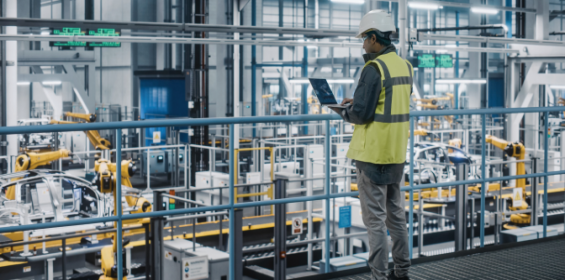Bridging the gap between CMMS & emerging technologies
Published: 21 May, 2025
CMMS platforms are evolving, but integrating AI, IoT, and machine learning remains a major challenge. Compatibility issues, data inconsistencies, and a lack of expertise hinder adoption. To bridge the gap, businesses must prioritise modular systems, data standardisation, and phased implementation—ensuring technology enhances, rather than complicates, maintenance operations. PWE reports
In recent years, the role of Computerised Maintenance Management Systems (CMMS) has evolved dramatically. What was once a straightforward digital logbook for scheduling and tracking maintenance tasks is now expected to be an intelligent, predictive tool that helps organisations optimise their asset management. The shift towards predictive maintenance, driven by technologies such as Artificial Intelligence (AI), the Internet of Things (IoT), and Machine Learning (ML), is a logical progression. However, for many maintenance teams, this shift is proving to be a significant challenge.
The problem is not the technology itself—AI, IoT, and ML have been around for some time and are already making a huge impact in various industries. The challenge is integrating these technologies effectively with existing CMMS platforms. Many organisations, particularly those with legacy systems, are finding that their CMMS simply isn’t built to handle the influx of real-time data from IoT-enabled sensors or to apply machine learning algorithms to detect patterns in equipment failure. Instead of becoming more efficient, maintenance teams often find themselves bogged down by compatibility issues, inconsistent data, and unreliable system performance.
For businesses that have already invested heavily in their CMMS, the idea of scrapping the system and starting from scratch is both impractical and expensive. Upgrading is often the preferred route, but even that comes with its own set of hurdles. Many CMMS providers are rushing to offer ‘AI-powered’ or ‘IoT-ready’ features, yet in practice, these capabilities often fall short of what’s needed in real-world maintenance operations. Systems that claim to be fully integrated often require extensive customisation, additional middleware, or workarounds that undermine the very efficiency gains they promise.
Compounding the problem is a general lack of expertise in implementing and managing these new technologies. Maintenance professionals are experts in machinery and equipment, but they aren’t necessarily data scientists or software engineers. The result is a disconnect between the teams that develop CMMS software and the people who use it on the ground. Training is essential, but without the right tools and support, even the most skilled maintenance teams can struggle to make sense of vast amounts of data and extract meaningful insights.
Implementation
This isn’t to say that the integration of AI, IoT, and ML into CMMS is a lost cause. Far from it. There are businesses that have successfully implemented predictive maintenance strategies, using data-driven insights to reduce downtime and improve asset reliability. However, these success stories often involve organisations that have either built their CMMS with integration in mind from the outset or have been willing to invest significantly in bridging the gap between old and new technologies.
So what’s the solution? First and foremost, CMMS providers need to prioritise seamless integration with emerging technologies rather than simply adding features as an afterthought. Open Application Programming Interfaces (APIs) and modular system designs should be the standard, allowing organisations to adopt new technologies without overhauling their entire infrastructure. For maintenance teams, investing in upskilling is key—training on data interpretation, AI applications, and IoT monitoring will help bridge the knowledge gap and empower professionals to make the most of their systems. Additionally, businesses should approach integration in phases rather than attempting a full-scale implementation all at once. Starting with small pilot projects can help identify potential issues early and allow teams to adapt before rolling out changes more broadly.
Furthermore, collaboration between CMMS vendors and end-users must improve. Vendors should actively seek input from maintenance teams during the development of new features to ensure they are practical and truly beneficial. Many software providers focus on selling a vision of the future rather than addressing the immediate, everyday challenges maintenance teams face. More transparency is needed when it comes to the true capabilities of a system before organisations commit to significant investments.
Another key aspect is data standardisation. Many businesses struggle with integrating new technologies because data is stored in different formats across multiple systems. Ensuring that CMMS platforms support universal data formats and seamless data sharing across departments will reduce friction and enhance overall system effectiveness. A lack of standardised data management often leads to inefficiencies and errors that counteract the very benefits that AI and IoT are meant to provide.
Regulatory compliance is also a consideration. Many industries have strict regulations regarding data security and equipment maintenance records. As CMMS platforms evolve, they must continue to align with compliance requirements while leveraging new technologies. Organisations should assess whether new features introduced into their maintenance systems meet legal and operational standards, avoiding any costly compliance breaches.
Finally, companies should take a pragmatic approach to AI and IoT adoption. Rather than viewing these technologies as a silver bullet that will instantly transform maintenance efficiency, businesses should recognise that meaningful improvements take time. AI-driven maintenance is only as good as the data it is trained on, so the quality and accuracy of existing maintenance logs are crucial. If organisations have poor historical maintenance data, AI predictions will be unreliable. Therefore, ensuring high-quality data collection should be a priority before expecting AI to deliver significant benefits.
Ultimately, for CMMS to remain relevant in the modern industrial landscape, vendors must go beyond marketing buzzwords and focus on genuine compatibility, ease of use, and seamless integration. Organisations, in turn, need to be realistic about the effort required to make these technologies work effectively. AI and IoT have the potential to revolutionise maintenance, but only if they are implemented in a way that enhances—not complicates—the work of the people using them. By focusing on practical implementation, structured data management, and targeted upskilling, organisations can bridge the gap between traditional CMMS and cutting-edge maintenance technology, ensuring a smoother transition into the future.







